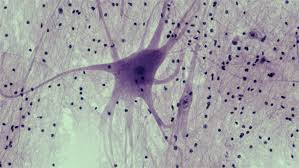
Introduction
- Nervous tissue ek interconnected network hota hai specialised cells ka, jise neurons (nerve cells) kehte hain, jo neuroglial cells dwara supported hote hain.
- Human beings mein approximately 10 million neurons hote hain.
- Neurons ka kaam stimuli receive karna aur unhe central site (central nervous system – CNS) tak conduct karna hota hai, jahan unka analysis aur integration hota hai, taki effector organs mein desired response produce ho sake.
Classification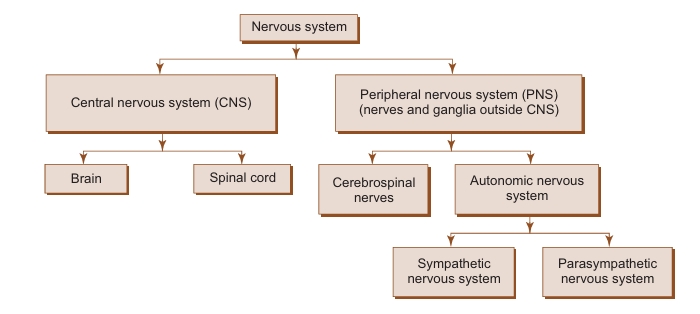
A. Morphological (Processes ki number ke adhar par)
-
Unipolar neuron—Ek single process hota hai (rare), jaise ki mesencephalic nucleus of V cranial nerve.
-
Bipolar neuron—Do processes hote hain (ek axon aur ek dendrite; Fig. 9.1), jaise ki spiral ganglion, bipolar cells in retina, etc.
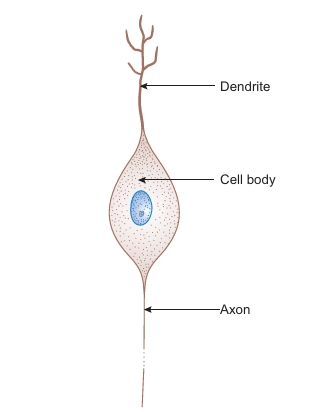
-
Multipolar neuron—Kai processes hote hain (ek axon aur kai dendrites; Fig. 9.2), jaise ki autonomic ganglia motor neurons, etc.

-
Pseudo-unipolar neuron—Ek single process hota hai jo axon (central process) aur dendrite mein divide hota hai, jaise ki cranial aur spinal ganglia (sensory neurons).
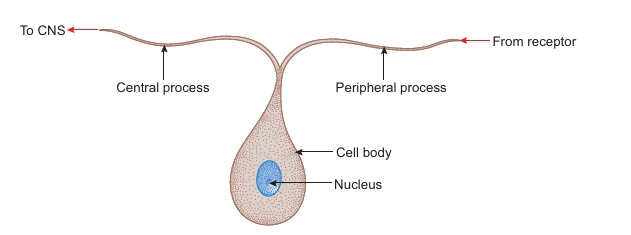
B. Functional (Karyon ke adhar par)
-
Sensory neuron—Receptors se stimuli receive karta hai aur impulses ko CNS tak conduct karta hai, jaise ki sensory ganglia.
-
Motor neuron—CNS se effector organs (muscles) tak impulses conduct karta hai, jaise ki ventral horn cells.
-
Interneuron—Sensory aur motor neurons ko connect karta hai aur functional circuit complete karta hai.
Neuron Structure
Cell body (5–150 μm):
-
Nucleus—Bada, euchromatic, spherical aur centrally located hota hai.
-
Nissl bodies ya Nissl substance—Bade aggregations hote hain rough endoplasmic reticulum ke, jo light microscopy se basophilic clumps dikhte hain, dendrites tak extend hote hain par axon aur axon hillock mein nahi. Ye axon ke injury se disintegrate ho jaate hain.
-
Golgi complex—Nucleus ke paas hota hai.
-
Mitochondria—Bohat saare aur rod-shaped hote hain.
-
Neurofilaments (10 nm dia) aur microtubules (25 nm dia)—Neuron ka cytoskeleton banate hain jo structural support aur intracellular transport provide karte hain.
-
Melanin pigments—Dark brown granules.
-
Lipofuscin pigments—Residual bodies jo lysosomes se digest nahi hote, aur age ke saath increase hote hain.
Dendrites
- Ye highly branched, tapering processes hote hain. Inka diameter uniform nahi hota.
- Ye thorny spines (gemmules) se covered hote hain, jo synaptic contact ke sites hote hain.
- Ye stimuli ko sensory cells aur dusre neurons se receive karte hain aur soma ki taraf transmit karte hain.
Axon
- Ek single, long, cylindrical process hota hai neuron ka, jiska diameter uniform hota hai.
- Ye zyada branch nahi karta, lekin collaterals de sakta hai.
- Ye axon hillock se arise karta hai, jo cone-shaped portion hota hai cell body ka, aur Nissl bodies se devoid hota hai, lekin microtubules ke bundles contain karta hai.
- Axon ka cytoplasm ko axoplasm aur plasma membrane ko axolemma kaha jata hai. Ye terminal boutons ke form mein small swellings mein divide hota hai.
Myelinated aur Unmyelinated Axons
- PNS mein, sabhi axons Schwann cells ke dwara enveloped hote hain, jo structural aur metabolic support provide karte hain.
- Kai axons jo chhote diameter wale hote hain, ek Schwann cell ke andar invaginate karte hain aur Schwann cells ke cytoplasm se surrounded hote hain.
- Inhe unmyelinated nerve fibres kaha jata hai.
- Bade myelinated axons mein nerve impulse node se node tak jump karta hai, jis se faster conduction (saltatory conduction) hota hai.
- Do nodes ke beech ka myelin segment internode kehlata hai. Ek internode ka myelin ek Schwann cell banata hai.
Peripheral Nerve
Har peripheral nerve (spinal ya cranial) bundles (fascicles) se banta hai nerve fibres (axons) ke, jo myelinated aur unmyelinated ho sakte hain. Ye bundles connective tissue se jude hote hain, jo structural support aur nutritional support provide karta hai by carrying blood vessels to nerve fibres. Connective tissue framework ko nerve ke cross-section mein achhe se dekha ja sakta hai, jahan following structures observe hote hain: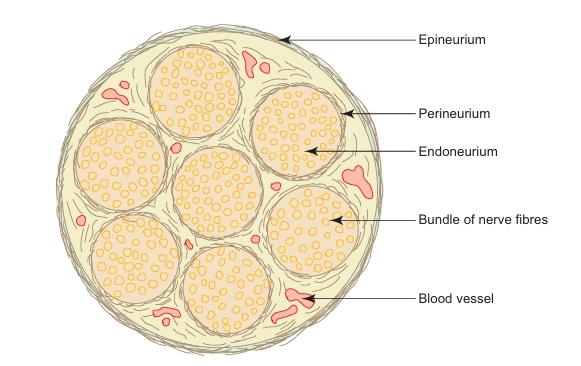
-
Epineurium: Poore nerve ko surround karne wala dense connective tissue sheath.
-
Perineurium: Nerve fibres ke bundles ko surround karne wali flattened epithelial cells ki sleeve.
-
Endoneurium: Loose connective tissue jo individual nerve fibres ko support karta hai.
Ganglia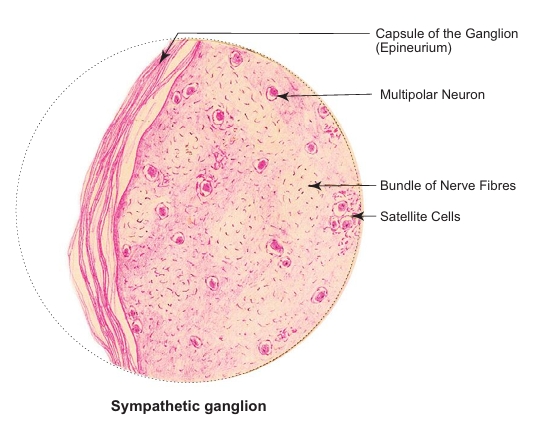
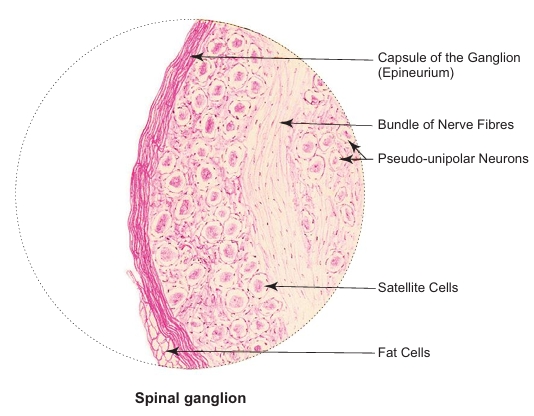 Ganglia oval bodies hoti hain, jo neuron ke cell bodies ke aggregation se banti hain, jo CNS ke bahar hoti hain.
Ganglia oval bodies hoti hain, jo neuron ke cell bodies ke aggregation se banti hain, jo CNS ke bahar hoti hain. - Ye relay centres ka kaam karti hain neuronal pathway mein.
- Ye usually dense connective tissue capsule se covered hoti hain, jo epineurium ke naam se jana jata hai.
- Neuron ke cell bodies ek layer of cuboidal cells se surrounded hote hain, jise satellite cells kaha jata hai.
- Ganglia ke do types hote hain morphology aur function ke adhar par: sensory aur motor ganglia.
Cerebral Cortex
Cerebral cortex grey matter se bana hota hai jo cerebral hemisphere ko cover karta hai. Cortex ka surface area convolutions ya gyri ke presence ke karan badhta hai, jo sulci ke dwara separated hote hain. Cortex nerve cells, fibres, neuroglia aur blood vessels ka mixture hota hai.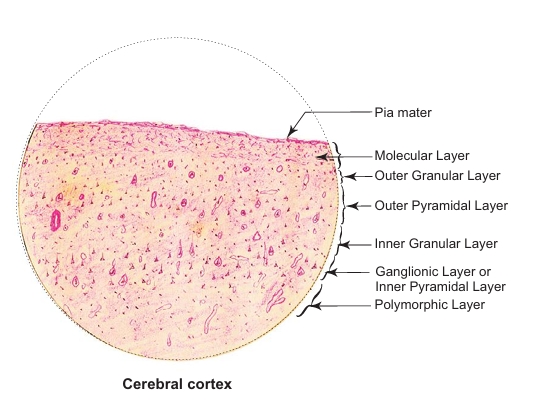
Types of Nerve Cells
Cerebral cortex mein paaye jaane wale nerve cells ke paanch types hote hain:
-
Pyramidal cells: Ye sabse common neurons hote hain cerebral cortex mein. Ye pyramidal shape ke hote hain. Inka size 10 μm se 120 μm tak hota hai. Motor cortex mein giant pyramidal cells (120 μm) ko Betz cells kaha jata hai. Inke apices dendritic processes ko generate karte hain, jo cortex ke surface ki taraf directed hote hain, jabki bases axons ko generate karte hain jo white matter ke projection fibres banate hain. Ye layers 2–5 mein distributed hote hain aur progressively size mein badhte hain.
-
Stellate/Granule cells: Chhote, star-shaped neurons jo uniform diameter ke hote hain (8 μm). Inke short axons nearby neurons mein terminate hote hain.
-
Fusiform cells: Spindle-shaped cells jo deep layer mein surface ke right angle pe place hote hain. Inke dendrites cell body ke har pole se arise karte hain, aur axon lower pole se arise hota hai aur white matter mein enter karta hai.
-
Horizontal cells of Cajal: Ye bhi spindle-shaped cells hote hain, par horizontally oriented hote hain, surface ke parallel superficial layer mein. Inke dendrites har pole se arise karte hain, aur axon cell body se arise hota hai aur horizontally run karta hai, pyramidal cells ke dendrites ke saath contact banata hai.
-
Cells of Martinotti: Small multipolar cells jo layers 3–6 mein paaye jaate hain. Inke axons cortex ke surface ki taraf directed hote hain aur generally molecular layer mein end hote hain.